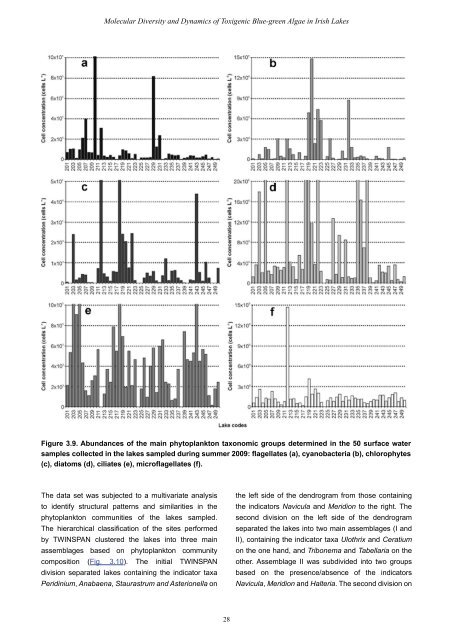STRIVE - Environmental Protection Agency
STRIVE - Environmental Protection Agency
STRIVE - Environmental Protection Agency
You also want an ePaper? Increase the reach of your titles
YUMPU automatically turns print PDFs into web optimized ePapers that Google loves.
Molecular Diversity and Dynamics of Toxigenic Blue-green Algae in Irish Lakes<br />
Figure 3.9. Abundances of the main phytoplankton taxonomic groups determined in the 50 surface water<br />
samples collected in the lakes sampled during summer 2009: flagellates (a), cyanobacteria (b), chlorophytes<br />
(c), diatoms (d), ciliates (e), microflagellates (f).<br />
The data set was subjected to a multivariate analysis<br />
to identify structural patterns and similarities in the<br />
phytoplankton communities of the lakes sampled.<br />
The hierarchical classification of the sites performed<br />
by TWINSPAN clustered the lakes into three main<br />
assemblages based on phytoplankton community<br />
composition (Fig. 3.10). The initial TWINSPAN<br />
division separated lakes containing the indicator taxa<br />
Peridinium, Anabaena, Staurastrum and Asterionella on<br />
28<br />
the left side of the dendrogram from those containing<br />
the indicators Navicula and Meridion to the right. The<br />
second division on the left side of the dendrogram<br />
separated the lakes into two main assemblages (I and<br />
II), containing the indicator taxa Ulothrix and Ceratium<br />
on the one hand, and Tribonema and Tabellaria on the<br />
other. Assemblage II was subdivided into two groups<br />
based on the presence/absence of the indicators<br />
Navicula, Meridion and Halteria. The second division on

















